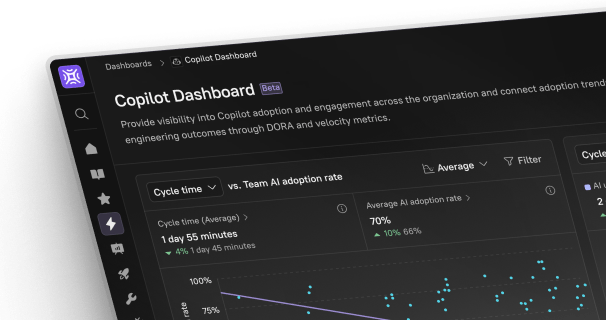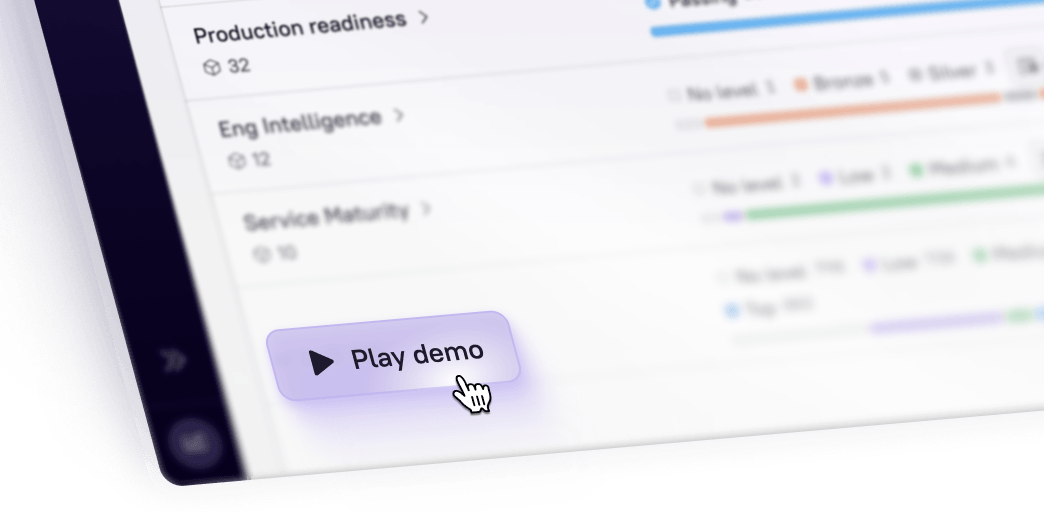Engineering teams might face the technical hurdle of legacy system dependencies or they might worry about downtime during deployments. This article dives into these challenges and provides strategies to overcome them.
Understanding AWS migration
An Amazon Web Services (AWS) migration involves moving applications, databases, and infrastructure to AWS while ensuring business continues and performance isn't impacted. Teams that migrate to AWS are typically aiming to achieve one or multiple of the following goals:
Reduce infrastructure costs through pay-as-you-go models
Improve scalability and reliability
Simplify operational complexity
Ensure better disaster recovery
Expand modernization opportunities
Accelerate deployment cycles and time-to-market
A successful migration can help organizations improve development velocity and innovate faster and more often, giving them a competitive advantage.
12 common cloud migration challenges in AWS
While each organization's cloud journey is unique, many face similar challenges during AWS migrations. Let's dive into the most common challenges:
1. Lack of a clear migration strategy and roadmap
Many teams underestimate the complexity of AWS migration by treating it as a purely technical endeavor. They miss a critical step of creating a cloud migration strategy that accounts for application dependencies, data volumes, and business continuity requirements. Without a clear strategy, migrations often face delays and cost overruns. Engineering teams need clear technical specifications, cloud migration patterns, and success criteria before starting the migration process.
2. Insufficient understanding of AWS services and architecture
AWS offers more than 200 services with different pricing models, configuration options, and use cases. Teams often struggle to choose the right services for their workloads. For instance, to choose between Amazon EC2, ECS, EKS, or Lambda for compute resources, teams must understand the performance characteristics, operational overhead, and cost implications of each option. If they don’t get this right, can lead to less-than-ideal architectural decisions that impact performance and costs.
3. Data migration complexities, including large volumes and sensitive data
Moving large datasets to AWS presents multiple technical challenges that can significantly impact project timelines, costs, and business operations. Network bandwidth constraints can substantially impact transfer speeds. Teams must maintain data consistency and navigate intricate data dependencies and relationships. Throughout this process, sensitive data demands robust encryption protocols, and all of this must be accomplished while maintaining uninterrupted service delivery.
4. Ensuring compliance with industry regulations like GDPR or HIPAA
Engineering teams must maintain compliance with regulations like GDPR, HIPAA, or SOC 2 during and after migration, which adds another layer of complexity. This involves implementing proper data encryption in transit and at rest. Teams must comply with data residency requirements, maintain detailed audit trails throughout the migration process, implement precise access controls and IAM policies, and maintain thorough documentation of compliance measures for auditor review.
5. Downtime and disruption during migration
Service interruptions during migration can result in substantial revenue loss, damaged customer trust, and missed SLA commitments. Zero-downtime migrations are often a requirement, particularly for organizations running business-critical applications for operations or customer-facing services. Teams must handle complex database replication and synchronization, develop traffic cutover strategies, and be prepared with rollback procedures in case of failures
6. Legacy system compatibility with AWS cloud architecture
Legacy applications often present complex migration challenges that extend beyond simple lift-and-shift operations. Many legacy systems depend on local filesystems or specific network resources with hard-coded configurations that don't translate well to cloud environments. These architectural decisions, while common in on-premises deployments, create significant obstacles when moving to AWS.
Further complicating matters, these applications frequently rely on outdated protocols or libraries that AWS doesn't support natively. This incompatibility often forces teams to undertake significant refactoring or modernization efforts before migration can even begin. The operating systems often have dependencies and limit cloud deployment options.
Additionally, even if there aren’t immediate compatibility issues, performance bottlenecks that weren't apparent in on-premises environments often surface during migration, as the different characteristics of cloud infrastructure expose underlying architectural issues that were previously masked by local hardware configurations.
7. Managing costs and avoiding unexpected expenses
Cost management in AWS requires deep technical understanding and continuous oversight. Engineers must master the art of right-sizing instances based on actual resource utilization patterns, often requiring detailed performance monitoring and analysis. The cost implications of different storage classes and data transfer between AWS services and regions can significantly impact the overall budget.
In a cloud environment, zombie resources—orphaned volumes, unused snapshots, or forgotten instances—can quietly linger and accumulate charges over time. Teams need to be especially careful of budgets with these unmonitored resources. Automation for cost optimization such as scheduled scaling and lifecycle policies for storage can help maintain control over cloud spending while maximizing the value of the AWS investment.
8. Security concerns, such as data breaches during migration
The shift to cloud introduces new attack vectors and security considerations that many organizations aren't prepared to handle. Teams must implement robust protocols for protecting data during transfer to AWS, often involving encryption mechanisms and secure transfer protocols. Secret management becomes more complex in cloud environments, requiring careful handling of credentials and secure storage solutions like AWS Secrets Manager.
Continuous security monitoring often requires teams to adopt new tools and approaches suitable for cloud environments. Identity and access management takes on new complexity, spanning both on-premises and cloud environments.
9. Skills gaps within the team or organization
Technical capabilities often lag behind migration ambitions in many organizations. While engineering teams may have deep expertise in traditional infrastructure, they frequently lack experience with Infrastructure as Code (IaC) practices essential for AWS deployments. Many developers have to shift their mindset to cloud-native development patterns, like building for eventual consistency or designing for failure.
10. Maintaining application performance post-migration
Engineering teams must understand AWS service limits and quotas- for example, the maximum number of EC2 instances per region or API request limits - to avoid unexpected throttling or capacity issues. Auto-scaling configurations like CPU utilization thresholds require careful tuning to balance responsiveness with cost efficiency, in particular during peak usage periods.
Additionally, distributed cloud services introduce latency considerations that weren't present in monolithic deployments. For instance, a database query that took milliseconds when running locally might take significantly longer when the application and database are in different availability zones. Teams must also implement effective caching strategies to minimize costs and improve response times while maintaining data consistency.
11. Limited monitoring and troubleshooting during and after migration
Traditional monitoring tools often don't translate well to cloud environments because they tend to focus on physical servers and struggle with dynamic, ephemeral cloud resources. This leaves visibility gaps during critical migration phases, and can lead to serious operational issues if not addressed early in the process.
Developers must understand application behavior and AWS-specific monitoring patterns to set up metrics and alarms. For example, monitoring container-based applications requires tracking cluster-level metrics, container health, and application performance across multiple instances. Distributed tracing helps debug microservices architectures, but implementing it across all services takes significant effort and code changes.
Log aggregation in cloud environments presents new challenges in terms of volume, storage costs, and accessibility. Creating meaningful dashboards that provide actionable insights requires deep understanding of both application architecture and AWS services.
12. Resistance to change from stakeholders or teams
Developers may resist new deployment processes that differ from their familiar workflows, particularly when they need to learn new tools or practices. Operations teams are often concerned about changing responsibilities and the potential loss of control in cloud environments. Management stakeholders often struggle with the change in expenditure models. Additionally, teams comfortable with existing tools and processes may hesitate to adopt new cloud-native approaches, even when they offer clear benefits.
How to overcome AWS migration challenges
Successful migrations require continuous refinement. The following strategies can be adapted and scaled based on your organization's specific needs, technical landscape, and migration goals. Each approach is designed to address multiple challenges while promoting engineering excellence throughout the migration.
Develop a migration strategy with clear goals and timelines
Your migration strategy should align technical requirements with business objectives. Document your current architecture, including all application dependencies, data flows, and integration points. Map each component to its AWS equivalent, considering factors like performance requirements, cost constraints, and compliance needs. Break down the migration plan into distinct phases with clear success criteria and rollback plans for each stage.
Leverage AWS migration tools to streamline planning and execution
AWS provides several native tools that can significantly simplify the cloud migration process. AWS Application Discovery Service analyzes your on-premises environment and plan migrations effectively. Building on this analysis, AWS Database Migration Service (DMS) enables seamless database migrations with minimal downtime. AWS Server Migration Service (SMS) complements these efforts by migrating on-premises servers to AWS. To make sure nothing falls through the cracks during the transition, AWS Migration Hub tracks the progress of application migrations across multiple AWS tools and solutions.
Adopt a phased approach to minimize downtime and disruptions
Break your migration into manageable phases using strategies like the 6 Rs of migration (Rehost, Replatform, Refactor, Repurchase, Retain, and Retire). Begin with non-critical applications to build team confidence and establish migration patterns. For each phase:
Implement traffic management strategies like blue-green deployments to enable seamless cutovers
Use AWS Route 53's weighted routing policies for gradual traffic shifting
Develop and thoroughly test rollback procedures before migration
Use an Internal Developer Portal to centralize and simplify workflows
An Internal Developer Portal (IDP) acts as a central hub for migration activities, providing developers with standardized tools and workflows. It can help track migration progress, manage cloud resources, and enforce best practices across teams. A portal like Cortex should provide clear documentation, deployment templates, and self-service capabilities that empower developers while maintaining governance controls.
Provide training to bridge knowledge gaps in AWS tools and services
Preparing your engineers for AWS will pay dividends. Focus on practical, hands-on training that covers key services relevant to your migration. Include topics like:
AWS architecture best practices
Infrastructure as Code using CloudFormation or Terraform
Container orchestration
Cloud security and compliance
Cost optimization techniques
Monitoring and observability in AWS
Implement cost management tools to control cloud spending
Establish robust cost control mechanisms from the start. Implement AWS Cost Explorer and AWS Budgets to monitor spending patterns and set up alerts for unusual cost spikes. Use AWS Organizations to manage multiple accounts and implement Service Control Policies (SCPs) for governance. Tag resources consistently to track costs by team, project, or environment.
Use security tools to protect data and ensure compliance
Implement data security measures using AWS's native security services:
Encrypt data at rest using AWS KMS (Key Management Service)
Implement AWS Certificate Manager for TLS certificate management
Use AWS Secrets Manager to safely store and rotate sensitive credentials
Enable AWS IAM Access Analyzer to identify unintended resource access
Invest in monitoring tools to maintain performance post-migration
Establish comprehensive monitoring using AWS CloudWatch, AWS X-Ray, and Amazon Managed Service for Prometheus and Grafana. Set up detailed dashboards that track key performance indicators across your applications. Implement automated alerting for performance degradation and resource constraints.
Streamline your AWS migration with Cortex
While tools and technologies form the foundation of a successful AWS migration, true engineering excellence requires a holistic approach that combines technical capabilities with organizational readiness. Engineering teams need a central platform that not only provides technical solutions but also promotes best practices, enables collaboration, and accelerates cloud adoption across the organization.
This is where Cortex comes in. Designed for engineering excellence, Cortex’s IDP serves as the connective tissue between your teams, tools, and AWS infrastructure. It goes beyond traditional migration tools by providing:
A unified view of your services, resources, and dependencies across your AWS environment, making it easier to plan and track migrations
Automated scorecards that measure migration readiness and progress against best practices
Built-in templates and playbooks that codify successful migration patterns
Real-time insights into service health, costs, and compliance during and after migration
Integration with your existing CI/CD pipelines and AWS tools to streamline workflows
To learn more about Cortex, book a demo.





